April 21, 2023
Jaime C.
The Death of Over a Thousand Garment Workers in Bangladesh
Global Research, April 21, 2023
Tricontinental 20 April 2023
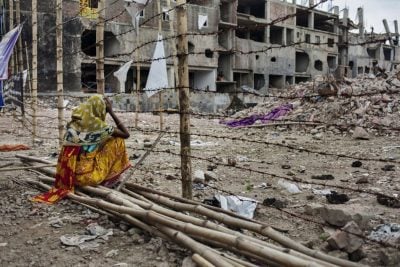
On Wednesday 24 April 2013, 3,000 workers entered Rana Plaza, an eight-story building in the Dhaka suburb of Savar in Bangladesh. They produced garments for the transnational commodity chain that stretches from the cotton fields of South Asia, through Bangladesh’s machines and workers, and on to retail houses in the Western world. Garments for famous brands such as Benetton, Bonmarché, Prada, Gucci, Versace, and Zara are stitched here, as are the cheaper clothes that hang on Walmart racks. The previous day, Bangladeshi authorities had asked the owner, Sohel Rana, to evacuate the building due to structural problems. ‘The building has minor damage’, said Rana. ‘There is nothing serious’. But at 8:57 am on 24 April, the building collapsed in the span of two minutes, killing at least 1,132 people and injuring over 2,500 more. The circumstances of the collapse were similar to the 1911 Triangle Shirtwaist Factory fire in New York City, where 146 people died. Tragically, a century later, garment workers are still subject to these dangerous labour conditions.
The list of avoidable ‘accidents’ in Savar is long and painful. In April 2005, at least 79 workers died in a factory collapse; in February 2006, 18 workers died in yet another collapse, followed by 25 in June 2010 and 124 in the Tazreen Fashion Factory fire in November 2012. Since the Rana Plaza devastation ten years ago, at least 109 other buildings in the area have collapsed, resulting in the death of 27 workers (at minimum). These are the deadly factories of twenty-first century globalisation: poorly built shelters for a production process geared toward long working hours, third-rate machines, and workers whose lives are submitted to the imperatives of just-in-time production. Writing about the factory regime in nineteenth-century England, Karl Marx noted in chapter 10 of Capital:
But in its blind unrestrainable passion, its werewolf hunger for surplus labour, capital oversteps not only the moral, but even the merely physical maximum bounds of the body. It steals the time required for the consumption of fresh air and sunlight. … All that concerns it is simply and solely the maximum of labour power that can be rendered fluent in a working day. It attains this end by shortening the extent of the labourer’s life, as a greedy farmer snatches increased produce from the soil by robbing it of its fertility.
Image: Poly Akhter’s mother, Shahana (38), grieves for her, 1 June 2013. Credit: Taslima Akhter
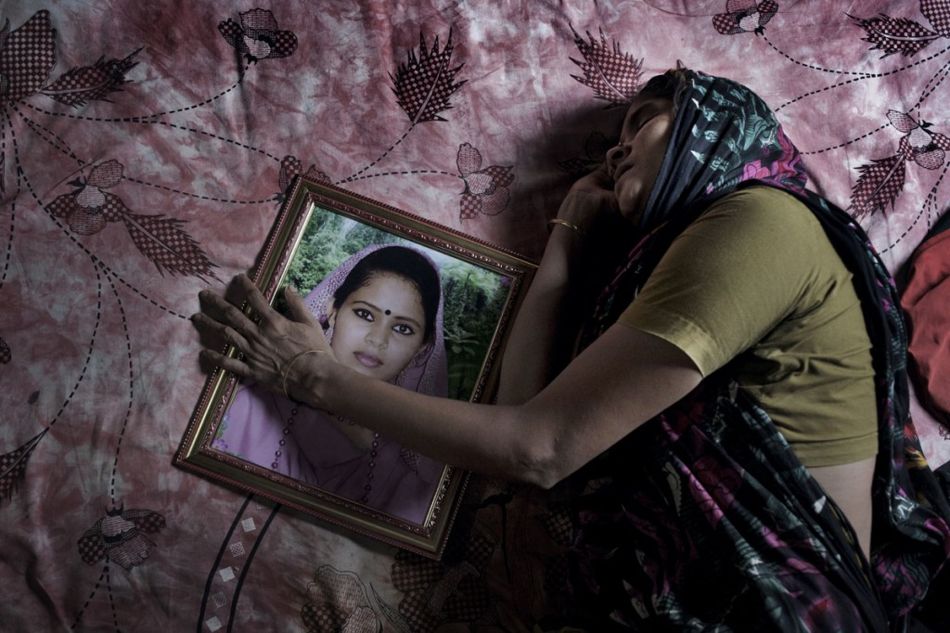
These Bangladeshi factories are part of the landscape of globalisation echoed in factories along the US-Mexico border, in Haiti, in Sri Lanka, and in other places around the world that opened their doors to the garment industry’s savvy uptake of the new manufacturing and trade order of the 1990s. Subdued countries that had neither the patriotic will to fight for their citizens nor any concern for the long-term debilitation of their social order rushed to welcome multinational clothing companies that no longer wanted to invest in factories. So, they turned to subcontractors, offering them narrow profit margins, compelling them to run their factories like prison houses of labour. The garment industry in Bangladesh, which comprises 80 per cent of the country’s total export earnings, grew entirely in security zones, offering workers few prospects to unionise. It is no wonder that these factories are a warzone.
Workers on the Edge in Bangladesh. Covid Lockdown Undermines Garment Industry
The subcontracting process allowed multinational firms to deny any culpability for the actions of small factory owners, allowing wealthy shareholders in the Global North to enjoy profits from the lower costs of production without having their consciences stained by the terror inflicted on these workers. Men like Sohel Rana, a local tough guy who oscillated between different political parties depending on who held power, became local thugs for multinational firms. After the collapse of the building, Rana was hastily disowned by all politicians and arrested (the trial against him continues, although he is out on bail).
Men like Rana assemble workers, shove them into these shoddy buildings, and ensure that they are beaten if they threaten to unionise while elites living in the mansions of Gulshan and Banani offer small gestures of liberalism through charity and the allowance of modest, but unfulfilled, labour laws. Labour inspectors are few, and – even worse – they are powerless. As the International Labour Organisation noted in 2020, ‘Labour inspectors have no administrative sanctioning power and cannot impose fines directly. However, they can file a case in the labour court, but the resolution of these cases usually takes a long time, and the fines imposed… do not provide a sufficient deterrent’. An occasional outburst of liberal sentiment in the Global North forces some companies to ‘self-regulate’, an exercise in whitewashing the horrors of the global commodity chain. Capitalist democracy requires this alliance of brutality and reform, of neofascism and paternalism. It celebrates the Ranas of the world until they become a liability, and then it simply replaces them.
Image: This harrowing photograph, taken on 25 April 2013 in Savar, Bangladesh, has come to be known as A Final Embrace. Credit: Taslima Akhter
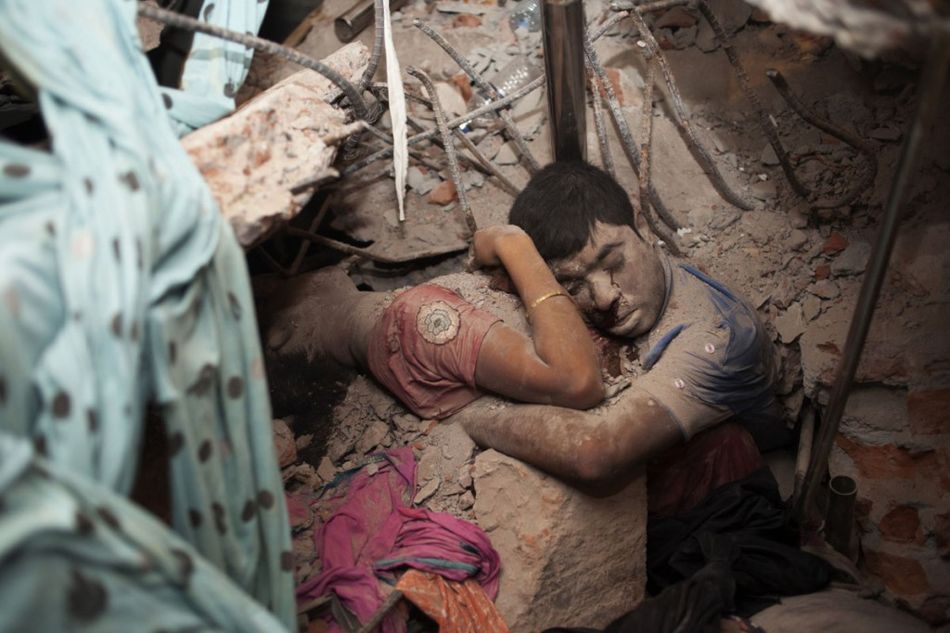
One day after the building collapse, Taslima Akhter went to Rana Plaza and photographed the ruins in what she saw as an act of remembrance. A selection of her photographs illustrates this newsletter. Later, Akhter published a 500-page book, Chobbish April: Hazaar Praner Chitkar (‘24th April: Outcries of a Thousand Souls’), which displays a collection of the posters put up by frantic family members looking for their loved ones and passport photographs of the dead with a brief note on their lives.
Chobbish April opens with the story of 35-year-old Baby Akhter, a swing operator at EtherTex Garment who began working at Rana Plaza only 16 days before her death. Akhter came to Dhaka from Rangpur, where her father was a landless peasant. Eighty per cent of the workers in these factories are women, and most, like Baby Akhter, migrate from conditions of landlessness. They bring with them the desolation of the countryside, its overworked soil and poisoned water ravaged by industrial agriculture as well as by the law of value that makes the small farmer redundant before the might of capitalist farms. Baby Akhter’s husband, Delowar, recalled that her luxuries were chewing paan (‘betel leaf’) and using a hand-held fan. ‘She was ready to fight any war’, he said. Her photograph exudes defiance and kindness, a smile hidden in her face.
Image: Baby Akhter. Credit: Bangladesh Garment Sramik Samhati (‘Bangladesh Garment Workers Solidarity’
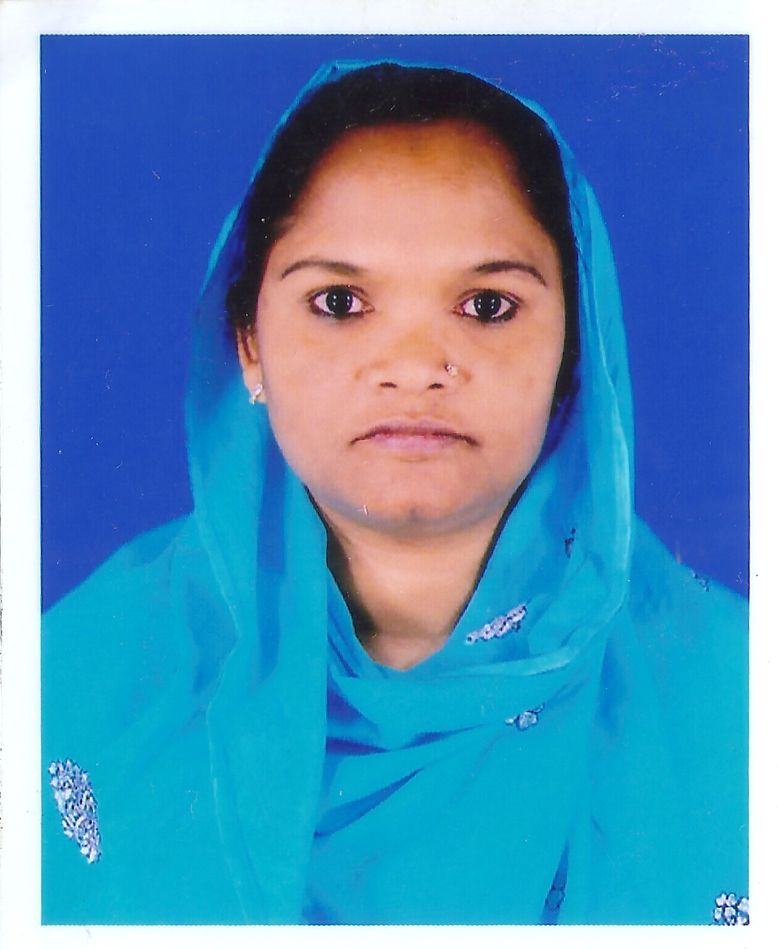
Bangladeshi workers like Baby Akhter have regularly organised to fight against their wretched conditions. In June 2012, the year before Rana Plaza collapsed, thousands of workers in the Ashulia Industrial Zone outside Dhaka protested for higher wages and better working conditions. For days on end, these workers closed 300 factories, blocking the Dhaka-Tangail highway in Narasinghapur. In retaliation, the owners shut down the factories, and the state took their side, with inspector Abul Kalam Azad declaring that the factories would only re-open if the workers ‘behaved properly’. Police officers marched down the street with batons and tear gas used to ‘educate’ the workers about so-called proper behaviour. After the 2012 protests, the government set up the Crisis Management Cell and the Industrial Police, both of which ‘collect intelligence and pre-empt labour unrest in industrial areas’. When Human Rights Watch investigated the situation in 2014–15, one worker told the investigator that despite being pregnant, she was ‘beaten with metal curtain rods’. One of the owners of a big factory explained to the investigator why the violence is viewed as necessary:
Factory owners want to maximise profits, so they will cut corners on safety issues, on ventilation, on sanitation. They will not pay overtime or offer assistance in the case of injuries. They push workers hard because they don’t want to miss deadlines… Workers have no unions, so they can’t dictate their rights… Some of this can also be blamed on the branded retailers who place bulk orders and say, ‘Scale up production lines because it is a big order and improve your margins’. Even 2–3 cents can make the difference, but these companies don’t want to factor [labour rights and safety] compliance into costing.
Each of these sentences seems lifted directly from Marx’s Capital, written over 150 years ago. The harsh conditions set by the global commodity chain make Bangladesh one of the worst countries in the world to be a worker. A studypublished in January 2023 shows that during the pandemic, multinational garment companies squeezed subcontractors to cut costs, which resulted in harsher conditions for workers.
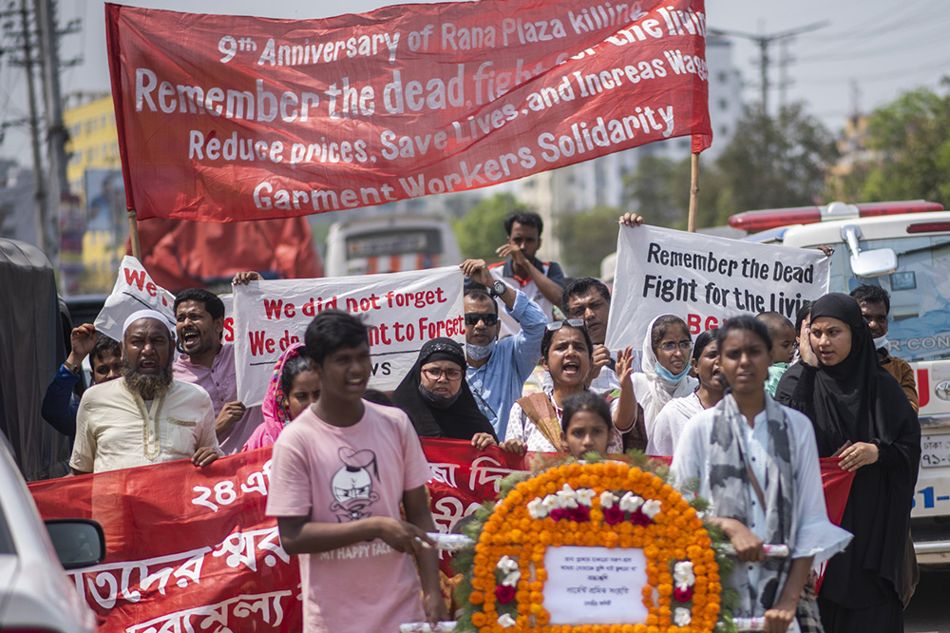
A commemoration march in 2022 on the ninth anniversary of the Rana Plaza collapse. Credit: Saifuzzaman Sium
In 1926, the All Bengal Tenants’ Conference met in Krishnanagar to form the Kirti Kisan (‘Worker-Peasant’) Party, an early communist political platform in South Asia. Kazi Nazrul Islam sang his Sramiker Gaan (‘Song of the Workers’) at this meeting, a poem that could have been written for Rana Plaza workers and for the millions who toil along a global commodity chain that they do not control:
We are mere coolies working at the machines
in these terrible times.
We are mere dupes and fools
to discover the diamond and to make a gift of it
to the king, to adorn his crown.
…
Hold fast your hammer, pick up your shovel,
sing in unison and advance.
Switch off the machine-light, the Satan’s eye.
Come along, O Comrade, and keep your weapon high.
*
Note to readers: Please click the share button above. Follow us on Instagram and Twitter and subscribe to our Telegram Channel. Feel free to repost and share widely Global Research articles.
Featured image: The mother of an 18-year-old missing worker, Rina, waits for her lost daughter in front of a barricade in Savar, Dhaka, Bangladesh, 24 July 2013. Credit: Taslima Akhter
The original source of this article is Tricontinental
Copyright Prof. Vijay Prashad, Tricontinental, 2023
Prof. Vijay Prashad, Tricontinental, 2023
https://www.globalresearch.ca/death-over-thousand-garment-workers-bangladesh/5816682
THANKS TO: https://counterinformation.wordpress.com/2023/04/21/the-death-of-over-a-thousand-garment-workers-in-bangladesh/
Jaime C.
The Death of Over a Thousand Garment Workers in Bangladesh
In memory of Dr Zafrullah Chowdhury (1941–2023)
By Prof. Vijay PrashadGlobal Research, April 21, 2023
Tricontinental 20 April 2023

On Wednesday 24 April 2013, 3,000 workers entered Rana Plaza, an eight-story building in the Dhaka suburb of Savar in Bangladesh. They produced garments for the transnational commodity chain that stretches from the cotton fields of South Asia, through Bangladesh’s machines and workers, and on to retail houses in the Western world. Garments for famous brands such as Benetton, Bonmarché, Prada, Gucci, Versace, and Zara are stitched here, as are the cheaper clothes that hang on Walmart racks. The previous day, Bangladeshi authorities had asked the owner, Sohel Rana, to evacuate the building due to structural problems. ‘The building has minor damage’, said Rana. ‘There is nothing serious’. But at 8:57 am on 24 April, the building collapsed in the span of two minutes, killing at least 1,132 people and injuring over 2,500 more. The circumstances of the collapse were similar to the 1911 Triangle Shirtwaist Factory fire in New York City, where 146 people died. Tragically, a century later, garment workers are still subject to these dangerous labour conditions.
The list of avoidable ‘accidents’ in Savar is long and painful. In April 2005, at least 79 workers died in a factory collapse; in February 2006, 18 workers died in yet another collapse, followed by 25 in June 2010 and 124 in the Tazreen Fashion Factory fire in November 2012. Since the Rana Plaza devastation ten years ago, at least 109 other buildings in the area have collapsed, resulting in the death of 27 workers (at minimum). These are the deadly factories of twenty-first century globalisation: poorly built shelters for a production process geared toward long working hours, third-rate machines, and workers whose lives are submitted to the imperatives of just-in-time production. Writing about the factory regime in nineteenth-century England, Karl Marx noted in chapter 10 of Capital:
But in its blind unrestrainable passion, its werewolf hunger for surplus labour, capital oversteps not only the moral, but even the merely physical maximum bounds of the body. It steals the time required for the consumption of fresh air and sunlight. … All that concerns it is simply and solely the maximum of labour power that can be rendered fluent in a working day. It attains this end by shortening the extent of the labourer’s life, as a greedy farmer snatches increased produce from the soil by robbing it of its fertility.
Image: Poly Akhter’s mother, Shahana (38), grieves for her, 1 June 2013. Credit: Taslima Akhter
These Bangladeshi factories are part of the landscape of globalisation echoed in factories along the US-Mexico border, in Haiti, in Sri Lanka, and in other places around the world that opened their doors to the garment industry’s savvy uptake of the new manufacturing and trade order of the 1990s. Subdued countries that had neither the patriotic will to fight for their citizens nor any concern for the long-term debilitation of their social order rushed to welcome multinational clothing companies that no longer wanted to invest in factories. So, they turned to subcontractors, offering them narrow profit margins, compelling them to run their factories like prison houses of labour. The garment industry in Bangladesh, which comprises 80 per cent of the country’s total export earnings, grew entirely in security zones, offering workers few prospects to unionise. It is no wonder that these factories are a warzone.
Workers on the Edge in Bangladesh. Covid Lockdown Undermines Garment Industry
The subcontracting process allowed multinational firms to deny any culpability for the actions of small factory owners, allowing wealthy shareholders in the Global North to enjoy profits from the lower costs of production without having their consciences stained by the terror inflicted on these workers. Men like Sohel Rana, a local tough guy who oscillated between different political parties depending on who held power, became local thugs for multinational firms. After the collapse of the building, Rana was hastily disowned by all politicians and arrested (the trial against him continues, although he is out on bail).
Men like Rana assemble workers, shove them into these shoddy buildings, and ensure that they are beaten if they threaten to unionise while elites living in the mansions of Gulshan and Banani offer small gestures of liberalism through charity and the allowance of modest, but unfulfilled, labour laws. Labour inspectors are few, and – even worse – they are powerless. As the International Labour Organisation noted in 2020, ‘Labour inspectors have no administrative sanctioning power and cannot impose fines directly. However, they can file a case in the labour court, but the resolution of these cases usually takes a long time, and the fines imposed… do not provide a sufficient deterrent’. An occasional outburst of liberal sentiment in the Global North forces some companies to ‘self-regulate’, an exercise in whitewashing the horrors of the global commodity chain. Capitalist democracy requires this alliance of brutality and reform, of neofascism and paternalism. It celebrates the Ranas of the world until they become a liability, and then it simply replaces them.
Image: This harrowing photograph, taken on 25 April 2013 in Savar, Bangladesh, has come to be known as A Final Embrace. Credit: Taslima Akhter
One day after the building collapse, Taslima Akhter went to Rana Plaza and photographed the ruins in what she saw as an act of remembrance. A selection of her photographs illustrates this newsletter. Later, Akhter published a 500-page book, Chobbish April: Hazaar Praner Chitkar (‘24th April: Outcries of a Thousand Souls’), which displays a collection of the posters put up by frantic family members looking for their loved ones and passport photographs of the dead with a brief note on their lives.
Chobbish April opens with the story of 35-year-old Baby Akhter, a swing operator at EtherTex Garment who began working at Rana Plaza only 16 days before her death. Akhter came to Dhaka from Rangpur, where her father was a landless peasant. Eighty per cent of the workers in these factories are women, and most, like Baby Akhter, migrate from conditions of landlessness. They bring with them the desolation of the countryside, its overworked soil and poisoned water ravaged by industrial agriculture as well as by the law of value that makes the small farmer redundant before the might of capitalist farms. Baby Akhter’s husband, Delowar, recalled that her luxuries were chewing paan (‘betel leaf’) and using a hand-held fan. ‘She was ready to fight any war’, he said. Her photograph exudes defiance and kindness, a smile hidden in her face.
Image: Baby Akhter. Credit: Bangladesh Garment Sramik Samhati (‘Bangladesh Garment Workers Solidarity’
Bangladeshi workers like Baby Akhter have regularly organised to fight against their wretched conditions. In June 2012, the year before Rana Plaza collapsed, thousands of workers in the Ashulia Industrial Zone outside Dhaka protested for higher wages and better working conditions. For days on end, these workers closed 300 factories, blocking the Dhaka-Tangail highway in Narasinghapur. In retaliation, the owners shut down the factories, and the state took their side, with inspector Abul Kalam Azad declaring that the factories would only re-open if the workers ‘behaved properly’. Police officers marched down the street with batons and tear gas used to ‘educate’ the workers about so-called proper behaviour. After the 2012 protests, the government set up the Crisis Management Cell and the Industrial Police, both of which ‘collect intelligence and pre-empt labour unrest in industrial areas’. When Human Rights Watch investigated the situation in 2014–15, one worker told the investigator that despite being pregnant, she was ‘beaten with metal curtain rods’. One of the owners of a big factory explained to the investigator why the violence is viewed as necessary:
Factory owners want to maximise profits, so they will cut corners on safety issues, on ventilation, on sanitation. They will not pay overtime or offer assistance in the case of injuries. They push workers hard because they don’t want to miss deadlines… Workers have no unions, so they can’t dictate their rights… Some of this can also be blamed on the branded retailers who place bulk orders and say, ‘Scale up production lines because it is a big order and improve your margins’. Even 2–3 cents can make the difference, but these companies don’t want to factor [labour rights and safety] compliance into costing.
Each of these sentences seems lifted directly from Marx’s Capital, written over 150 years ago. The harsh conditions set by the global commodity chain make Bangladesh one of the worst countries in the world to be a worker. A studypublished in January 2023 shows that during the pandemic, multinational garment companies squeezed subcontractors to cut costs, which resulted in harsher conditions for workers.
A commemoration march in 2022 on the ninth anniversary of the Rana Plaza collapse. Credit: Saifuzzaman Sium
In 1926, the All Bengal Tenants’ Conference met in Krishnanagar to form the Kirti Kisan (‘Worker-Peasant’) Party, an early communist political platform in South Asia. Kazi Nazrul Islam sang his Sramiker Gaan (‘Song of the Workers’) at this meeting, a poem that could have been written for Rana Plaza workers and for the millions who toil along a global commodity chain that they do not control:
We are mere coolies working at the machines
in these terrible times.
We are mere dupes and fools
to discover the diamond and to make a gift of it
to the king, to adorn his crown.
…
Hold fast your hammer, pick up your shovel,
sing in unison and advance.
Switch off the machine-light, the Satan’s eye.
Come along, O Comrade, and keep your weapon high.
*
Note to readers: Please click the share button above. Follow us on Instagram and Twitter and subscribe to our Telegram Channel. Feel free to repost and share widely Global Research articles.
Featured image: The mother of an 18-year-old missing worker, Rina, waits for her lost daughter in front of a barricade in Savar, Dhaka, Bangladesh, 24 July 2013. Credit: Taslima Akhter
The original source of this article is Tricontinental
Copyright
https://www.globalresearch.ca/death-over-thousand-garment-workers-bangladesh/5816682
THANKS TO: https://counterinformation.wordpress.com/2023/04/21/the-death-of-over-a-thousand-garment-workers-in-bangladesh/






 Sat Mar 23, 2024 11:33 pm by globalturbo
Sat Mar 23, 2024 11:33 pm by globalturbo

